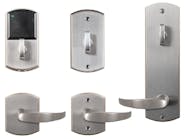People have been locking up their possessions forever. To secure possessions, there are specialized locks like door locks, vehicle locks and utility locks. These types of locks provide specific functions. They are not designed to be taken off and used for a different application.
Then there is the much used and abused padlock, the workhorse for securing all types of property including as a secondary locking mechanism for file cabinets. Padlocks were and still are used to lock doors for different kinds of buildings and a significant number of garage doors. In today’s economy, I have seen a few homes front doors “padlocked” shut. Some school and gym lockers are still secured by combination padlocks. They are used to keep toolboxes of varying sizes closed.
However, the padlock is only part of the locking mechanism. The closing mechanism, a hasp, is necessary for the padlock to secure the object. The basic hasp is a hinged metal fastener with a slotted end that fits over a separate fixed staple. The hinged portion of the hasp contains mounting holes for the screws. The padlock locks the closed hasp by sliding its shackle through the exposed staple, trapping the fastener. The mounting screws for the fastener and the staple are concealed when the hasp is in the closed position.
There are many different types and styles of hasps. In this article we will discuss the basic hasp and the special application hasps. For aesthetics, Phoenix Lock Company manufactures two styles cast solid brass safety hasps that are available in burnished brass, polished chrome and polished brass.
Hasps are manufactured of varying thickness and materials. The staple of a commercial grade hasp is normally a bent rod of hardened steel or other alloy that resists cutting or sawing. Sometimes the manufacturer will also harden the fastener near the staple opening. Some hasp manufacturers offer swivel staple hasps where the staple can rotate further restricting the opening. Lightweight hasps are designed for honest persons keeping things safe within the confines of their residence or garages. To add some strength, some hasp manufacturers rib the fastener. Most ferrous metal hasps are plated to protect against corrosion.
The combination padlock built onto a hasp is one of the variations. This “hasplock” has been around for many years. They are still available from Master Lock having a 1-3/4” laminated body warded padlock. They are also available with pin tumbler locks.
Over the years, the types and designs of the hasp have been modified to accommodate specific needs. The most common modification is the introduction of the heavy duty hasps. Heavy duty hasps are designed to resist being forcibly opened or removed. They are manufactured of hardened metals including steel and other metallic alloys to resist hammering, sawing cutting and other method of force.
For example, Abus has heavy duty hasps manufactured of white heart malleable iron, with a lower silicon content. This results in an alloy with good hardness and abrasion resistance. A hardened steel staple completes the hasp.
A variation of the heavy-duty hasp is making use of a larger staple. The large staple covers more of the exposed portion of the shackle, reducing the ability to cut or break the shackle. Some padlocks are specifically designed to operate in conjunction with this type of hasp.
From the straight hasp designed for flat surfaces comes the right-angle hasps where the fastener is bent 90 degrees and slides over the staple. Right-angle hasps can be used to secure sliding and in swinging doors.
Hinge hasps were developed to secure hard to lock property including securing two uneven surfaces, around a corner or at angles. The fastener can be two, three or four pieces hinged together with hidden pins and hard metal links. This configuration provides the flexibility between the fastener’s mounting screws and the staple. Hinged hasps are available in varying lengths.
Neck bolts, surface bolts, offset surface bolts and other padlockable bolts can be grouped as laminated steel plate locking bolts. These locks use different shaped bolts to secure applications including roll up entry and drive-in doors. Laminated bolt locks have varying throw lengths at different positions. The standard bolt lock is almost flush with the surface. The offset bolt lock can be more than one inch away from the surface to accommodate an obstruction such as a parting strip. Locking bolts are available in a variety of sizes and accommodate different types of strike plates. Most locking bolts can be locked in the secured position and the unlocked position.
Garage door hasps incorporate a steel bolt with two padlock eyes welded onto the base. One eye is for the locked position with the bolt extending into the jamb. The second eye is the unlocked position to prevent accidental locking. Major Manufacturing’s Garageblok is a jimmy-proof shielded garage door hasp with built-in lock shield and 5/8” diameter hardened steel bolt. The handed housing is manufactured from 3/16” thick zinc chromate plated steel. The Garageblok is anchored to the door with four supplied 5/16” carriage bolts, washers and nuts.
Angle hasps or padlock eyes provide closing capability for double swinging or sliding doors, wood gates or even cabinet doors or drawers. They are available in varying sizes and styles. Padlock Eyes are probably the most inexpensive type of hasp available. They are normally sold without mounting screws.
The two-part American Lock A810 Gate Hasp is designed to attach to chain link gates and fencing poles that are 1-5/8” or 2” in diameter, where the opening is between three and six inches. The locking mechanism is a sliding fastener that interconnects to the two halves of the gate hasp. To lock the gate the fastener is slid to the stop position. Once in position, a padlock shackle up to 7/16” in diameter and at least one inch vertical shackle clearance secures the fastener and the gate from opening. Four carriage bolts secure this gate hasp in place.
Pacific Lock’s PAC-LINK is a higher security option to the cable or chain locks that can be used to secure gates or fences. PAC-LINK incorporates a hockey puck padlock with a stainless steel investment casting that fits beneath and around the padlock. One end of the chain is bolted into the casting. The other end of the chain slides into a slot in the casting. The hockey puck fits into the casting, on top of the two ends of the chain, and offers a high level of security because of the inability to attack the ends of the chain or the base of the padlock. PAC-LINK will accept up to one half-inch thick link chain. The casting can be welded or bolted onto a fence or gate.
A variation of the angle hasp is the van or vending machine hasp. The Master Lock No. 770 Solid Steel Hasp is a two-piece hasp with exposed mounting bolt holes and side protection for the padlock. The No. 770 hasp is designed to be operated using a “hockey puck” style of padlock. The “Hockey Puck” style padlock uses a straight shackle to provide the locking mechanism. This way the padlock connection to the hasp is concealed. This hasp has a welded metal partial ring that surrounds all but the lock cylinder of the padlock preventing prying and other forms of force.
A specialized application of the van lock is the Pacific Lock Truck-Puck Locking System (TPLS). The compact TPLS is designed to secure box truck roll up doors. Like the van lock system, the TPLS locking device leverages the strengths of a “hockey-puck” lock to secure a truck roll-up door. Unlike the van lock system, the TPLS is portable and can be moved from one vehicle to another. The two components of the TPLS, the Lock Body and Locking Bolt, combine an anti-saw shield with 1/4” thick steel. A hardened steel hockey-puck lock is welded onto the front completely hiding the shackle. When the TPLS is installed, the rollup door handle cannot tilt up in order to unlatch the door. The TPLS is available with a hockey-puck lock that can also be fitted with Small Format Interchangeable Cores or Key-in-Knob style cylinders.
Safety lockout hasps are designed not specifically for security, but more for agreement control. These aluminum, steel or stainless steel scissors like hasp have multiple openings; usually six punched into each half of the hasp. Padlock shackles can slide into each of the slots and be locked. When more than one padlock is locked onto a safety lockout hasp, all of the padlocks must be unlocked and removed in order to regain control. Example applications for the safety lockout hasp is to be connected to an energy disconnect switch or controls in order to keep equipment inoperable.
The file cabinet locking bar provides additional security for metal file cabinets. These padlocking bars are mounted onto the front of the file cabinet, which does not block adjoining file cabinets in either unlocked or locked positions. The locking bar slides into or out of the locked position of the mounting bar. When in the locked position and padlocked, the locking bar cannot be raised, obstructing the drawers from being opened. Also in the locked position, the mounting screws are concealed. The file cabinet locking bar can also be installed onto rollaway cabinets or any steel drawer equipped cabinet.
The final hasp for this article is the Padlockable Cam, a cam style utility lock that uses a padlock for the locking mechanism. Instead of having a built-in key operated locking mechanism, the Padlockable Cam has an “L” shaped arm extending from the housing and a similar “L” shaped arm extending from the plug area. Rotating the plug arm rotates the cam. A 0.400” diameter eyelet in each of the arms accommodates the padlock shackle. From the rear, Padlockable Cam looks just like a standard 1-1/8” long, threaded housing cam lock. This FJM Security Product fits into a standard cam lock cutout or a 3/4” diameter hole. It is designed to accommodate different styles of cams.
The variety of padlocks and hasps has made securing just about everything possible. With the different sizes, types and styles of padlocks available, there is security for just about every budget.
An additional plus is the ability for many padlocks to be purchased with a pin tumbler cylinder having a keyway that is compatible with commercial and residential locks. This gives the end user the ability to key the padlocks into an existing keying system.
For additional Locksmith Ledger articles on padlocks, visit Web Site: http://www.tinyurl.com/hasp0310




